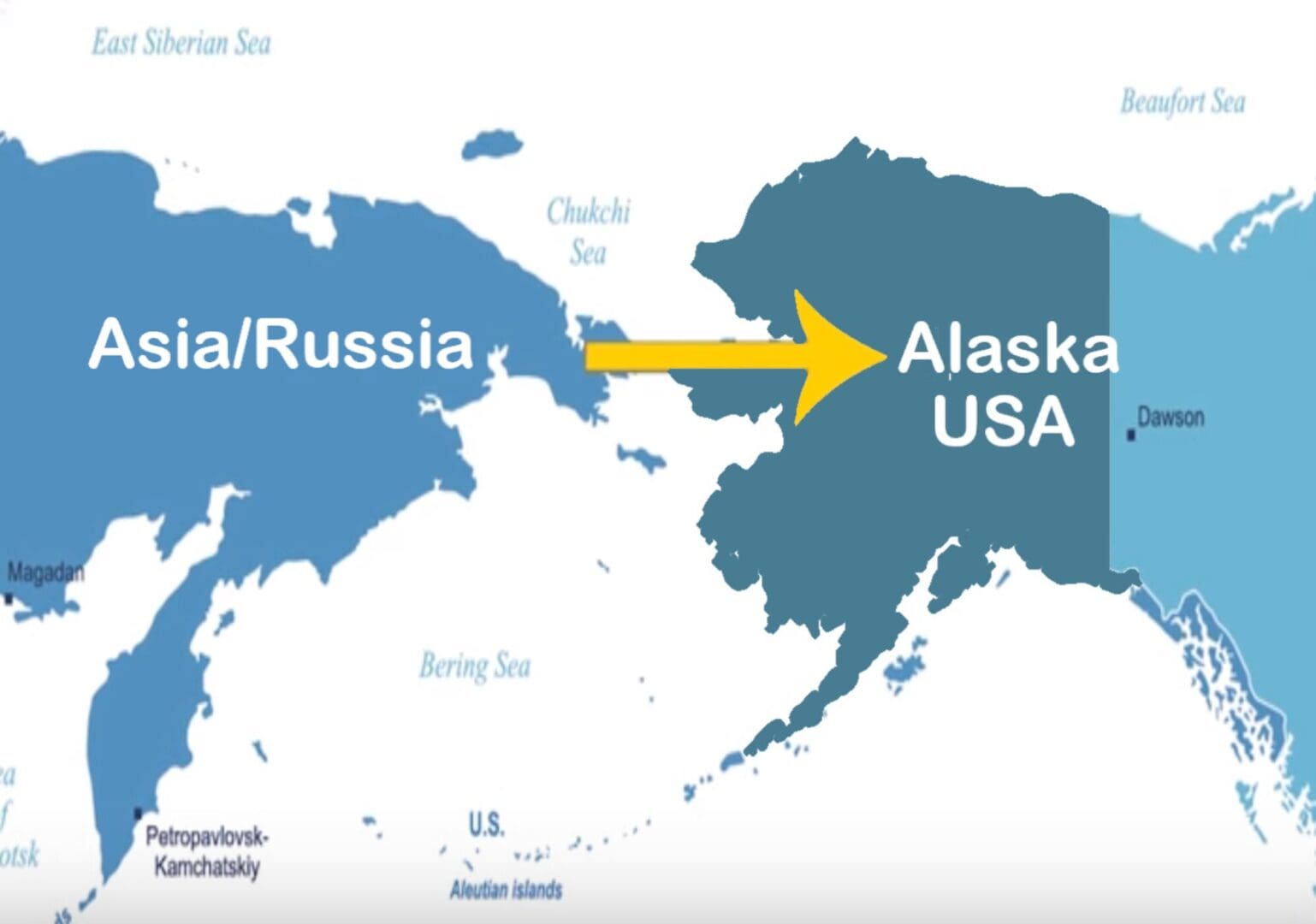We have Much in Common to Share

[1]Bering Strait Land Bridge Migration Theory
To understand what Alaska has in common with Philippines one must look back in history, before the 18th Century to what is now the State of Alaska (665,400mi²). This vast area was inhabited by Natives believed to have crossed the Arctic/Polar Zone land bridge from Russia and adapted to Polar-Subpolar-Temperate climates to build distinct cultures and a unique civilization. The more than 7,000 Philippines island (115,831 mi²) archipelago was originally inhabited by other Asian Native people who were quite comfortable in their Tropical Climate Zone abundance.

First documented European contact with Philippines was made in 1521 byFerdinand Magellanin hiscircumnavigation expedition,during which he was killed in theBattle of Mactan.


Forty-four years later, a Spanish expedition led byMiguel López de Legazpileft modern Mexico and began the Spanish conquest of Philippines. Legazpi’s expedition arrived in the Philippines in 1565, during the reign ofPhilip II of Spain, whose name has remained attached to the country.
[2]Early Mapping of Southeast Asia, Suaraz, Thomas, 1999.
Spanish claims to the Alaska region dated to thePapal Bull of 1493, but never involved colonization, forts, or settlements. Instead, Madrid sent out various naval expeditions to explore the area and to claim it for Spain. In 1775Bruno de Hezetaled an expedition; theSonora, underBodega y Quadra, ultimately reachedlatitude 58° north, entered Sitka Sound and formally claimed the region for Spain. The 1779 expedition ofIgnacio de Arteagaand Bodega y Quadra reachedPort Etches onHinchinbrook Island, and enteredPrince William Sound. They reached a latitude of61° north, the most northern point attained by Spain.

Russianexpeditions of exploration reached Alaska by the early 18th century, and colonial traders (especiallyfur-traders) followed. On some islands and parts of the Alaskan peninsula, groups of Russian traders proved capable of relatively peaceful coexistence with the local inhabitants. Other groups could not manage the tensions and perpetrated exactions. Hostageswere taken, individuals were enslaved, families were split up, and other individuals were forced to leave their villages and settle elsewhere. In addition, during the first two generations of Russian contact, eighty percent of the Aleut population died ofOld Worlddiseases, against which they had noimmunity.

Aleut People perform traditional dance in the Aleutian Archipelago.
[3]The Aleut Corporation. Aleut History.
Life for Indigenous Peoples Occupied by Invaders
Before the Spaniards came to Philippines, aboriginal people enjoyed the fruits of the lands. They tilled the lands and lived in abundance since the lands were fertile and every plant could grow. Food was sufficient and no native went hungry.
Sounds almost Biblical, doesn’t it?
Everything changed with coming of the Spaniards. They divided the archipelago into the encomiendas, an economic ststem which resulted in exploitation of the Natives. Over some 333 years of occupation, the Spaniards awarded lands they usurped as royal grants to the colonial officials and Catholic religious orders in exchange for their conquest of the Natives. The encomenderos extended the scope of their royal grants by usurping ownership of the lands previously developed by the people. More lands were turned into agricultural lands and feudal exploitation of the natives became worse.
[4]Understanding Philippine History; Readings and Discourse
The Alaska Experience was Similar–with Russian conquests.
In 1784Grigory Ivanovich Shelikhovarrived inThree Saints BayonKodiak Island, operating the fur-tradingShelikhov-Golikov Company. Shelikhov and his group killed hundreds of indigenous Alaskan Koniag, then founded the first permanent Russian settlement in Alaska – on the island’s Three Saints Bay. By 1788 Shelikhov and others had established a number of Russian settlements over a large region, including the mainland areas aroundCook Inlet.

Numerous Russian Orthodox Churches around Alaska have unique steeples. This one is located on the Kenai Peninsula of Southcentral Alaska.
[4]A History of the Russian-American Company.
Russian fur-traders informally introduced theRussian OrthodoxChurch (with its rituals and sacred texts translated into Aleut at a very early stage) in the 1740s–1780s. During his settlement of Three Saints Bay in 1784, Shelikov introduced the first resident missionaries and clergymen.


Russian Orthodox Church in Manila.
The United States of America was founded in 1776 by mostly Anglos from Europe. Manifest Destiny would ultimately conquer Native “Indian” frontier inhabitants to conclude its Westward Expansion in Alaska and Hawaii. Alaska was purchased from Russia in 1867.
5]Manifest Destiny, Encylopedia Britanica

The content below was originally paywalled.
Today the largest city in Alaska, Anchorage is located on Cook Inlet, which was founded by English Explorer Captain James Cook. He was killed in Hawaii by Hawaiian Natives February 14, 1779 at age 50.

Death of Captain James Cook.
By Johann Zoffany – nmm.ac.uk, Public Domain, https://commons.wikimedia.org/w/index.php?curid=11348403
In 1788Esteban José MartÃnezandGonzalo López de Harovisited Russian settlements atUnalaska Island in the Aleutian Chain.
As the Russians forced Native Alaskans to hunt primarily fur seals and sea otter, by contrast, the Spaniards in Philippines instituted feudalism on a wide scale through the encomienda system and compulsory cultivation of certain crops for export during the latter part of the 18th century.
Feudalism as a mode of production required control of the peasants and the land. This relationship was one of oppression by landlords and exploitation of the peasantry, in which vast areas of cultivable land were owned by a few landlords who themselves did not till the land but compelled a large number of tenants to do the tilling.
[5]ibid, Understanding Philippine History; Readings and Discourse
Thus, 1565 to 1898 is called theSpanish Era. During the period thePhilippine Islandswere ruled as theCaptaincy General of the Philippineswithin theSpanish East Indies, initially under the Kingdom of theVice-royalty of New Spain, based inMexico City. Independence of the Mexican Empirefrom Spain in 1821 resulted inSpanish controlduring aperiod of governmental instabilitythere. The Philippines was under direct royal governance 77 years, from 1821 to 1898.
In the later years of the 18th century,Governor-General José Basco introduced economic reforms that gave the colony its first significant internal source income from the production of tobacco and other agricultural exports.
[6]Spanish Rule of Philippines
Philippine People Struggled under Spanish Imperialism
While Alaskans suffered benign neglect as a western strategic enclave of the USA, Native Filipinos were subjected to servitude from Spain through its cruel encomenderos system enriching friars in the Catholic Church. Feudalism meant most wealth gravitated to Spain.
This situation was similar for Alaska dependence upon the USA but we were poor and development expensive in this climate zone. With a very small population and a dozen or more tribes of indigenous people over this vast area, the only economic hope for Alaska was development of vast natural resources including furs, fish, gold, timber and other minerals including oil. First the Fur Rush, then the Gold Rush, and most recently the Oil Rush have fueled Alaska’s boom-and-bust economy with a mostly transient population beyond the indigenous people of Asian descent.
[6] Why Alaskans Wanted Statehood
An ongoing debate in Philippines, and at times open conflict, during the Spanish colonial period, was between the religious orders and the civil administration. Underlying the debate was the question of who was truly soverign in the archipelago, the Vatican or Madrid? It as clear from the Patronato Real* that the Spanish monarch held soverign sway over all matters pertaining to the conditions in the colony, be these in the secular or the spiritual realm, including oversight of the appointment of religious personnel to the distant colony. On the ground, however, it was a far different story as to who held actual power, at least as far as the local populace was concerned.
Instructional note: The Spaniards came to the Philippines for conquest and the propagation of the Catholic Church. The basic concept of the propagation of the Catholic Church was the Patronato Real or Royal Patronage. It wasan agreement between theKingof Spain and the Pope of Rome.
[7]A History of the Philippines.
Philippines Becomes US Spoils of Spanish-American War
Again, from Encyclopedia Britanica:
The so-called New Manifest Destiny was a way of clothing imperial ambitions in a higher purpose ostensibly decreed byProvidence. The Spanish-American War of 1898 arose from popular outrage over Madrid’s reportedly barbarous colonial policies inCubaand, more immediately, in response to destruction of the U.S. BattleshipMaine, but it ended with the United Statesacquiringremnants ofSpain’sdwindling global empire, including Philippines.
[8]Destruction of Battleship Maine in Havana Harbor, February 15,1898
The Spanish-American War began in 1899, officially ending a mere four months later in 1902. The Filipino people were not keen on having a new master established by the Treaty of Paris, thus causing the 1899 Philippine-American War. In fact, the Philippine-American war continued for a decade and far surpassed the Spanish-American War in ferocity, cost and duration, but history is written by the victorious and the USA remains today in denial about getting whipped by the Filipino military after the minimal skirmish with Spain.
During this time Alaska was being overrun by people from all over the world seeking gold.
NEXT: Philippines National hero, Jose Rizal.
References:
[1]Bering Strait Land Bridge Theory
https://healthresearchfunding.org/bering-strait-land-bridge-theory-explained/
[2]Suaraz, Thomas (1999).Early Mapping of Southeast Asia: The Epic Story of Seafarers, Adventurers, and Cartographers Who First Mapped the Regions Between China and India. Periplus Editions (HK) Limited. p.138.ISBN9789625934709.
[3]The Aleut Corporation. Aleut History.
“The Aleut Corporation Aleut History”. 2 November 2007. Archived fromthe originalon 2 November 2007. Retrieved19 March2018.
[4]CH 4 Social, Political, Economic and Cultural issues, P 76.
Understanding Philippine History; Readings and Discourse, Amaliia C Rosales, et al., Lorimar Publishing, In. 10-B Boston St., Bgy Kaunlaran, Cubao, Quezon City, Metro Manila, 2020.
[5[Tikhmenev, P. A.A History of the Russia-American Company.ed. Richard A. Pierce and Alton S. Donnelly. Seattle: University of Washington Press. 1978, p. 12.
[6] Manifest Destiny, Encyfclopedia Britanica
https://www.britannica.com/event/Manifest-Destiny
Before theAmerican Civil War(1861–65), the idea ofManifestDestiny was used to validate continental acquisitions in the Oregon Country,Texas,New Mexico, andCalifornia. The purchase ofAlaskaafter the Civil War briefly revived the concept of Manifest Destiny, but it most evidently became a renewed force in U.S.foreign policyin the 1890s, when the country went to war withSpain, annexedHawaii, and laid plans for an isthmian canal acrossCentral America.
Historical Development of Feudalism in the Philippines
[7]Oxford Dictionary: Feudalism
The dominant social system in medieval Europe, in which the nobility held lands from the Crown in exchange for military service, andvassalswere in turn tenants of thenobles, while thepeasants(villeinsorserfs) were obliged to live on their lord’s land and give him homage, labor, and a share of the produce, notionally in exchange for military protection.
[8]Spanish Rule of Philippines
Hedman, Eva-Lotta E.; Sidel, John T. (2000).Philippine Politics and Society in the Twentieth Century: Colonial Legacies, Post-Colonial Trajectories. Routledge. pp.6-7.ISBN9780415147903.
[9]Why Alaskans wanted statehood Part 1
https://donnliston.co/2018/10/why-alaskans-wanted-statehood-october/

United States Senator Ernest Gruening characterized Alaskan history before statehood as being one of neglect by the federal government. He labels the period of 1867 to 1884 as “The era of Total Neglect”; 1884 to 1898 as “The Era of Flagrant Neglect”, 1988 to 1912 “The Era of Mild but Unenlightened Interest”; and finally the period from 1912 to 1933 as “The Era of Indifference and unconcern.”2
[10] A History of the Philippines; from Indios Bravos to Filipinos, Luis H. Francia, The Overlook Press, New York, 2010. P 69 Destruction of Battleship Maine in Havana Harbor, February 15,1898
[11]Destruction of Battleship Maine in Havana Harbor, February 15,1898
https://www.britannica.com/event/destruction-of-the-Maine




